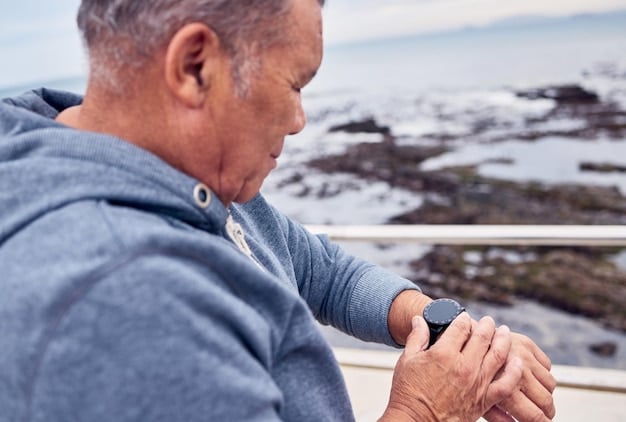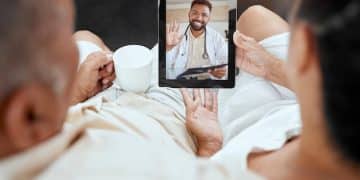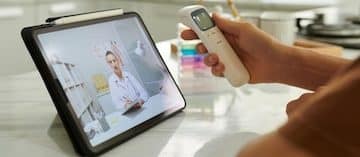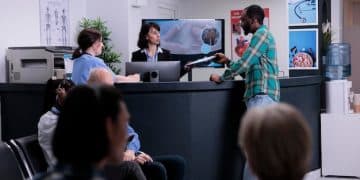Telehealth for Seniors: Remote Monitoring for Better Health & Lower Costs

Telehealth for seniors, utilizing remote monitoring technology, offers a promising approach to enhance their quality of life by providing accessible care, reducing healthcare expenses, and enabling proactive and personalized health management from the comfort of their homes.
The aging population is growing, and with it, the challenges of providing accessible and affordable healthcare. Telehealth for seniors offers a significant opportunity to address these challenges. Remote monitoring, a key component of telehealth, empowers seniors to manage their health proactively, while allowing healthcare providers to deliver timely and personalized care, ultimately improving quality of life and reducing healthcare costs.
Understanding Telehealth and Remote Monitoring
Telehealth encompasses a broad range of technologies and services used to provide healthcare remotely. Remote monitoring, a crucial part of telehealth, involves using devices to collect and transmit patient data to healthcare providers. This data can include vital signs, activity levels, and other health indicators.
What is Telehealth?
Telehealth uses technology to bridge the gap between patients and providers separated by distance. It includes video conferencing, remote monitoring, and mobile health apps.
What is Remote Monitoring?
Remote monitoring allows healthcare providers to track a patient’s health data from a distance, enabling timely interventions and personalized care plans.
- Collecting vital signs like blood pressure and heart rate
- Tracking activity levels and sleep patterns
- Monitoring medication adherence
- Providing early warnings for potential health issues
Telehealth and remote monitoring improve access to care, especially for seniors in rural areas or with mobility issues. They allow healthcare professionals to maintain and observe a patient’s health. Providing a method for faster intervention.

Benefits of Telehealth for Seniors
Telehealth technologies offer seniors opportunities for improved health outcomes and autonomy. Several benefits that seniors might experience when using telehealth technologies are:
Improved Access to Care
Telehealth eliminates transportation barriers and brings healthcare directly to seniors homes, making it easier for them to receive medical attention.
Reduced Healthcare Costs
By preventing hospital readmissions and promoting early intervention, telehealth can significantly lower healthcare expenses for seniors and their families.
- Fewer trips to the emergency room
- Reduced need for hospitalizations
- Lower transportation costs
- Preventive care at home
Telehealth has been proven effective to enable a method for elderly people to stay healthy in their own home. Providing constant analysis that can indicate a possible larger problem.
Conditions Managed Effectively via Telehealth
Telehealth can manage a variety of chronic conditions common among seniors. This technology does not only lower costs and allows early detection, it also promotes better understanding of the patients condition.
Telehealth and remote monitoring are particularly useful for managing chronic conditions, providing continuous support and preventing complications.
Diabetes Management
Remote monitoring of blood glucose levels can help seniors better manage their diabetes and avoid dangerous fluctuations.
Heart Failure Monitoring
Telehealth enables healthcare providers to track fluid retention, weight changes, and other vital signs, allowing for early intervention in cases of heart failure.

Implementing Telehealth Solutions for Seniors
To implement telehealth solutions for seniors it is important to understand that not all elderly people are tech savvy. Making technology easy to use is a major priority.
Successful telehealth implementation requires careful planning and consideration of seniors needs and preferences. Important considerations include a good internet connection and a caregiver.
Choosing the Right Technology
Select devices and platforms that are easy to use and specifically designed for seniors, with features like large buttons and clear displays.
Training and Support
Provide training and ongoing support to help seniors and their caregivers become comfortable using telehealth technologies.
- Offer simple, step-by-step instructions
- Provide telephone support for troubleshooting
- Conduct in-home training sessions
- Offer ongoing education and resources
Training and support should be available. Making sure the senior is capable to continue using telehealth solutions. Encouraging a senior to use the technologies regularly improves acceptance and confidence.
Overcoming Challenges and Ensuring Success
While telehealth offers many advantages, there are also barriers that need to be addressed to ensure its successful adoption among seniors.
To successfully integrate telehealth into seniors lives, it is crucial to address the challenges and foster a supportive environment.
Addressing Technology Literacy
Many seniors may have limited experience with technology, requiring patience and tailored training to help them overcome their apprehension.
Ensuring Data Security and Privacy
Protecting seniors personal health information is paramount. Use secure platforms and follow HIPAA guidelines to maintain confidentiality.
The Future of Telehealth for Seniors
Telehealth for seniors is rapidly evolving, with new technologies and applications constantly emerging. These advances hold great promise to transform senior care and enhance their quality of life.
The future of telehealth for seniors is bright, with advances in technology and growing acceptance promising even greater benefits.
Artificial Intelligence (AI) in Telehealth
AI-powered tools can analyze remote monitoring data to identify potential health problems early on, enabling proactive interventions.
Wearable Technology
Wearable devices, such as smartwatches and fitness trackers, can continuously monitor vital signs and activity levels, providing valuable insights into seniors health.
Expansion of Telehealth Services
Telehealth is expanding beyond traditional medical consultations to include mental health services, physical therapy, and other specialized care.
| Key Concept | Brief Description |
|---|---|
| 🏡 Access to Care | Telehealth improves senior access to medical care from their homes. |
| 📉 Cost Reduction | Telehealth can significantly lower healthcare costs by reducing hospital visits. |
| ❤️ Condition Monitoring | Telehealth allows for effective managing of chronic conditions like diabetes and heart failure. |
| 🤖 Future Tech | The future of telehealth includes AI and wearable tech for enhanced senior care. |
Frequently Asked Questions About Telehealth
▼
Telehealth uses technology to provide healthcare remotely, benefiting seniors by improving access to care, reducing costs, and enabling personalized health management from home.
▼
Remote monitoring involves using devices to collect and transmit patient data, such as vital signs, to healthcare providers, allowing for timely interventions and proactive care.
▼
Telehealth is effective in managing chronic conditions, including diabetes and heart failure, by providing continuous support and preventing complications through regular monitoring.
▼
Challenges include seniors with basic knowledge working the technology, ensuring data security, and integrating telehealth into existing healthcare workflows, requiring tailored training and support.
▼
The future of telehealth involves greater integration of AI and wearable technology, expansion of telehealth services, and increasing acceptance among seniors and healthcare providers.
Conclusion
Telehealth and remote monitoring offer a solution to improve senior care and to reduce healthcare costs. By knowing its benefits and taking action to implement simple steps and proper support telehealth can provide seniors with the opportunity to improve their health and well-being while remaining independent and comfortable in their own homes.





